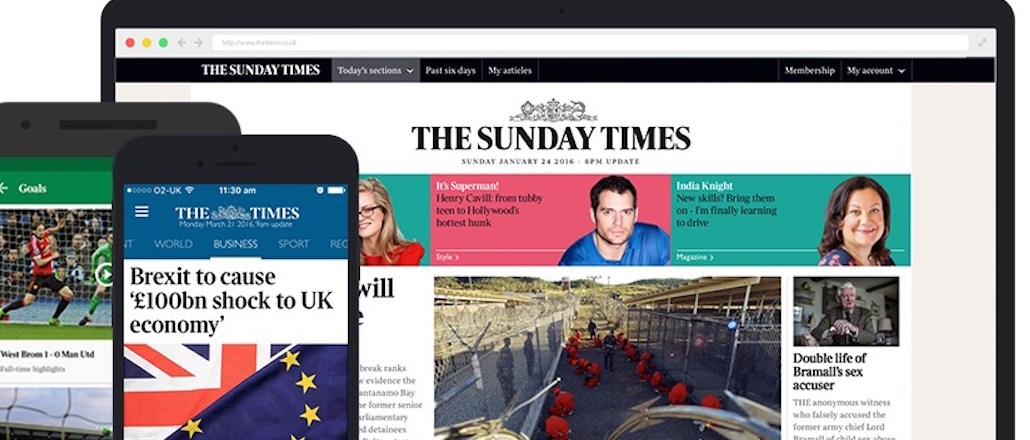Save 50% on a 3-month Digiday+ membership. Ends Dec 12.

British national newspaper The Times has been behind a hard paywall since 2010. That’s meant its speciality has long been in-depth analysis, opinion and commentary for its 402,000 Times and Sunday Times print and digital paying subscribers. It has still featured breaking news, and its sites have continuously updated to reflect that fast news metabolism.
Not any more: The Times wants off the breaking-news carousel entirely.
Instead, it wants to cultivate an editions-based schedule for publishing content digitally, and as it undergoes a major site-wide redesign, it will be merging The Times and The Sunday Times Websites to create a single destination, which will be updated three times a day: 9 a.m.; midday and 5 p.m. BST.
“Readers don’t come to us for breaking news; they can go to the BBC and Twitter for that, which are free,” said Alan Hunter, The Times head of digital. “They come to us for the authority of our reporting, opinion and analysis. Breaking news has become a commodity, and it’s hard to charge people for it. We believe in the power of digital editions.”
While The Times has run live blogs and other forms of breaking news, they haven’t had good uptake, according to Hunter. “People talk about content shock and the feeling of being bombarded with a torrent of news day in, day out, hour by hour. There’s a feeling they can’t keep up. We want to help them make sense of it and ensure our readers know what’s important,” he added.
Slowing its digital news metabolism to spend longer producing in-depth articles for the Web, comes along with a radical design overhaul of The Times and Sunday Times Websites, which have been separate (and unresponsive) since 2010. The previous reader experience was somewhat disjointed, with different designs and branding on each of the sites, compared to the tablet and smartphone apps. “We had a complicated estate,” said Hunter.


The new website has been designed to give a cleaner user experience and will feature The Times masthead from Monday to Saturday, which will change to The Sunday Times on the last day of the week. Each title will retain its separate editors and teams. There will be no redundancies, according to the publisher, but the addition of a four-person team will handle the curation of the mobile and Web experiences. The paper will be appointing a new smartphone and Web editor, along with a deputy and an assistant. All print content, along with additional Web-only stories will run online.

Each site has been designed specifically for mobile devices to avoid the usual design trade-offs responsive sites are forced into, Hunter said. Subscription prices won’t change. Currently, it costs £5 ($7) a week for the “Classic 6 day Pack” which gives access to website, smartphone and print newspaper. The “Ultimate pack,” which includes that plus tablet app, will run £8 ($11.4) a week. There are numerous other packages.
The titles already run a combined Apple and Android tablet and smartphone app, which will relaunch with the new designs and enhanced features along with the website. Tablet app subscribers rose by 10,000 last year — taking the total to 78,000 people, while 91,000 people access the app for The Sunday Times, according to the publisher. Average dwell times are 44 minutes on the Times content and 65 minutes on the Sunday Times. Its international Times of London app will remain the same.


The publisher has dropped the section heads along the top — a feature rarely used by readers, according to Hunter. Instead, it will feature a “Past 6 Days,” tab, which gives access to the previous six editions of both titles. But the section heads, Business, World, Technology, Money, Opinion, Sport, will all feature as part of the main page, which people can scroll down. “Essentially we’re making our site one long homepage,” added Hunter.
Last week, The Times Newspapers revealed a pre-tax profit of £10 million ($14.3 million) for the year ending June 2015 — its first pre-tax profit since 2002. The new products are the fruits of 18 months worth of subscriber analysis: a mix of data analytics and surveys. A quarter of the title’s subscribers have been directed to the beta site for the last three months, its longest-ever beta phase.
Advertising slots will run after every section, and each article will have an ad placement after the fifth paragraph. Soon the site will feature Unruly video ads, courtesy of parent News UK’s acquisition of the video ad company last year.
Nick Baughan, U.K. CEO of Group M media agency Maxus, said the changes are a sensible move for the publisher, at a time when differentiation beyond editorial perspective, has become all but extinct in general news. “This is a smart evolution of The Times’ paywall strategy and how it monetizes content effectively,” he said.
“Currently, newspapers are all chasing the same ad money,” he added. “A title like The Times differentiating itself like this even further from free-access news sites like the Guardian, helps me as a media buyer, understand how to better leverage those platforms more effectively than if they’re doing the same thing.”
Images: courtesy of The Times.
More in Media

The Washington Post debuts AI-personalized podcasts to hook younger listeners
The Washington Post has used AI to build a pick-your-own-format news podcast, letting listeners choose the topics, hosts and duration.

Workforce data, smarter AI integration among greatest workplace priorities in the new year
The growing importance of workforce data is just one of the prognostications people managers are making looking to the year ahead.

WTF is AI citation tracking?
Publishers are tracking AI citations to understand visibility, attribution gaps and referral traffic in these tools and platforms.





